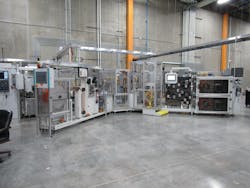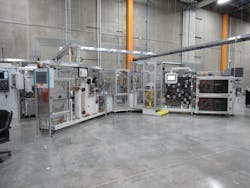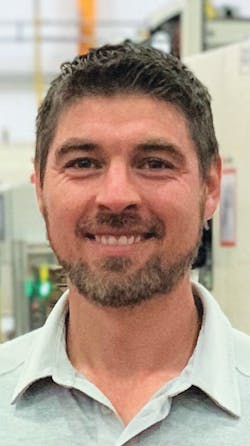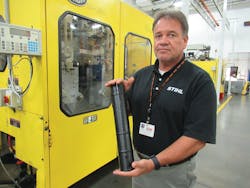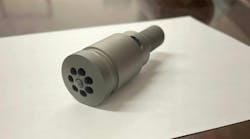The plastics processing part of Stihl’s plant employs more than 400 people who run 90 injection molding machines, six extruders and four blow molding machines. Stihl officials describe it as one of the largest captive technical molding operations in the U.S. It produces more than 150 million molded parts a year and more than 350,000 miles of trimmer line.
It is a vertically integrated, highly automated operation that can mold some parts more cost- effectively than Stihl’s Chinese plant.
“The only major remaining difference is the labor,” he said. “If we have a highly automated process and good quality, we can compete.”
The Virginia Beach plant competes with Stihl manufacturing plants in Germany, Switzerland, Austria, Brazil and China for every project. Each part is made where it makes the best financial sense, Hoffmann said. The Virginia Beach plant ships some common parts to other Stihl plants in Germany, Brazil and China.
In addition to automation, Stihl depends on a workforce with experience and training levels rarely seen in the plastics industry. Average tenure in the plant is more than 10 years and process technicians must have a Master Molder I certification from RJG. A Master Molder training class is typically held each year in the Virginia Beach plant. The certification is optional for set-up technicians, but they are welcome to take the course to improve their career opportunities.
There are currently more than 30 Master Molders in the plant.
“Having standardized training for those people means they speak the same language,” Hoffmann said. “You don’t get people on different shifts doing things differently. They all use the same approach. It makes us more successful.”
There is also significant standardization in primary and auxiliary equipment brands to reduce spare part inventories, provide flexibility on the plant floor and reduce training requirements.
Hoffmann said that when a new processing machine is purchased, Stihl specifies exactly what it wants. “We do very thorough pre-acceptance testing and have strict runoffs requirements. For automation, we look for cycle times and process capability. We have high expectations that we verify before the machine hits the floor,” he said.
An injection molding machine is generally running about one week after it is delivered, he said. “We install our temperature control unit, connect the hoses, maybe add an eDart system from RJG, and the machine is ready to run.
“We have high expectations. We typically achieve 92 percent to 97 percent overall equipment effectiveness,” he said. “You can only do that if your machines run when they need to run and don’t break down. We need good machines to do that.”
The high level of equipment availability and capability gives Stihl a competitive advantage, Hoffmann said.
INJECTION MOLDING
Stihl’s injection molding operation has two divisions: a polymers production division with 61 molding machines that have clamping forces ranging from 40 tons to 660 tons, and an accessories division with 28 machines with 100 tons to 300 tons of clamping force. Eight new presses are being installed this year.
The polymers production division molds the more complicated parts and includes insert molding, core pulls, overmolding and pad-printing operations. The 55,000-square-foot, football-field-sized plant floor includes more than 15 integrated automation cells.
The company has replaced 16 older Engel presses with molding machines from KraussMaffei in the polymers production division over the past few years. “We considered changing to new machines from another brand to further improve our equipment availability and reduce our spare parts inventory. We visited other plants and looked at other machines, and at some point, we saw advantages with KraussMaffei in terms of spare parts availability, service and support,” Hoffmann said. “It was a difficult decision and took four years to make the change.”
The molding machines Stihl uses are getting larger as the company manufactures larger products. Chain saws have historically been Stihl’s main product, but today they account for only about half of the plant’s output. “The biggest growth in large plastic part production is seen in products such as blowers or trimmers,” Hoffmann said. “To accommodate the larger backpack blower parts, we have added four 660-ton machines, and we plan to add more in the future.
“Our strategy has shifted,” he said. “Years ago, we had a lot more 50-ton to 100-ton machines. Currently, we are phasing out the 100-ton machines.”
The 80,000-square-foot accessories plant manufactures and assembles trimmer heads and has six vibration- and two infrared-welding cells. The welding machines are from Frimo and HA Industries Inc.
It also includes four blow molding machines.
The accessories division, which Stihl describes as a plant within a plant, has 28 Fanuc Roboshot injection molding machines with clamping forces ranging from 100 tons to 300 tons. The accessories division mostly makes drop parts that are bulk-packaged, and it has fewer secondary operations than the polymers production division.
Each of the Roboshot presses is equipped with a Yushin picker robot and conveyors with part diverters. More-complex operations in both molding divisions are generally handled by Fanuc robots.
“We try to reduce the operators in this plant to just material handling,” Hoffmann said. “Operators do quality checks once every hour and look at the parts, but otherwise they remove the full box and put an empty box in place.”
The 28-machine accessories molding division operates with six people per shift.
Stihl standardized on Roboshot presses more than 10 years ago when it decided to create the accessories factory. At the time, all-electric machines were new and Stihl molding officials recognized their advantages.
“At the time we started thinking about the accessories plant, we wanted to do everything right and buy new electric machines,” Hoffmann said. “Engel was our main vendor and for three months we ran one of their machines alongside a Roboshot and an electric press from Nissei.
“It was a close race between the Roboshot and the Nissei, and we decided to go with the Roboshot. Our original purchase was for 12 machines and now we have 28,” he said.
Stihl has more than 1,000 active molds and typically changes about one-third of its molds on the plant floor every day.
There is no formal machine replacement policy. “We replace on a case-by-case basis,” Hoffmann said. “We typically see molding machines reach the end of their life at 12 to 20 years, depending on the application. We replace six to eight machines a year and try to keep on top of the latest technology.”
BLOW MOLDING
All four blow molding machines are from Bekum; all are 6 years or older, but the oldest have been refurbished.
They are used primarily to manufacture tanks for chemical sprayers, as well as tubes that are used on blowers and other products and.
An automated procedure cuts off the ends of the tubes as they come out of the blow molding machine and the waste is diverted to a grinder, then back into the blow molder.
EXTRUSION
Stihl operates six 3.5-inch diameter single- screw extruders to manufacture trimmer line at the rate of more than 350,000 miles a year, more than enough to reach the moon.
Three older extruders were manufactured by Merritt Davis and three newer models are from Sima srl in Italy.
“We have had significant growth in this area over the past couple of years,” Hoffmann said. “In 2012, we had three extruders, so we have doubled capacity since then. We now process more than 8.7 million pounds of resin into trimmer line each year.”
The extrusion machines have recently been moved into a new, 50,000-square-foot building with a new materials-handling system. The facility also includes one injection molding machine.
The older machines have been upgraded to match the capabilities of the new Sima extruders and new downstream equipment has been added.
One challenge is that the line coming out of the extruder is wound onto 50-pound skeins, which must then be rewound into smaller packages for consumer sales. The Stihl team developed and patented a new package, shown at right, and a complex automation cell. “It is the most complex system we have here,” Hoffmann said. “It has a lot of robots and sensors.”
The winding cell was also the plant’s first big Industry 4.0 project. “We started using the system and wanted to improve it, but we could not get the data we needed to make improvements. The only way to do that is with an Industry 4.0-type solution.”
Hoffmann said the in-house engineering team is rolling out Industry 4.0 in areas where it is needed based on what it learned with the winding cell.
All automation equipment is networked with Ignition SCADA software from Inductive Automation in Folsom, Calif. All programming is done in-house.
AUTOMATION
Stihl has developed sophisticated automation solutions in-house. One application has two Fanuc robots handling pad printing on a part that requires a logo and a line printed around three sides. A vision system checks the printing on every part.
Another application saves floor space by having one robot tend two machines, remove the parts from the top of the machine and release them to move down a sloping conveyor.
Two halves of a fuel tank are molded in a family mold, assembled, welded, leak-tested and packaged in an automated cell that has just one operator.
Stihl processes 73 different resins totaling more than 35 million pounds per year. More than half arrives in tanker trucks and goes into one of 14 silos.
Each manufacturing area has its own materials- handling system, which primarily uses components from Una-Dyn. There is a central drying system in each area and vacuum conveying to the processing machines.
“We have done a lot of work over the years to improve those systems and have a couple of projects in the works now to add glass elbows and some glass straight pipes,” Hoffmann said. “We run very-high-glass-filled nylon, up to 40 percent glass, and it is abrasive.”
Hoffmann said the plant has experimented with Conair and other materials-handling equipment but has had the best experience with Una-Dyn. “They have good technical support and can respond quickly to our needs as their plant is only about two hours away,” he said.
Temperature-control units from Advantage Engineering or Regloplas are mounted inside the molding machine housings. Hot-runner controllers are from Gammaflux.
For quality control, Stihl uses Zeiss coordinate measuring machines.
The manufacturing execution system is a BMSvision PlantMaster system that has been in use for more than 15 years. “It may not have all the bells and whistles of some newer systems, but it does what we need it to do,” Hoffmann said.
The plant uses laser-guided vehicles (LGVs) to move finished parts around the molding complex. Hoffmann said the LGVs reduce forklift traffic and improve safety.
In addition to the Master Molder training and certification program, Stihl uses apprenticeships and internships to help identify prospective employees. It has a co-op with UMass Lowell that placed two students in the Stihl plant this summer.
There is also a highly competitive apprenticeship program that has been running since 1984 that selects five apprentices each year from about 300 applicants. The programs run for two and a half years to three years and have a 90 percent completion rate.
Stihl’s molding operation is unusual for several reasons — extensive use of automation, a highly trained workforce, the application of sophisticated engineering solutions to manufacturing issues and investment in high-quality processing equipment. It is no surprise that Stihl’s leadership thinks it can take on the world in producing high-quality parts with a competitive process.
Ron Shinn, editor
Contact:
Stihl Inc. Virginia Beach, Va., 800-467-8445,
